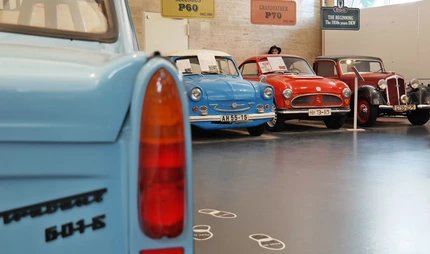
Polizeihistorische Sammlung
A behind the scenes look at the police of Berlin
Find out about 800 years of policing history at the Polizeihistorische Sammlung at Platz der Luftbrücke. The collection features original uniforms, weapons and vehicles through the ages, plus interesting items explaining police procedure and historical documents about real criminal cases.
Police work from the Middle Ages to the present day
1988 sees Berlin Police Chief Georg Shertz open the city's first police museum, and in 1990 it moves to its current location. 200 volunteers take charge of curating the exhibits. The museum's main purpose is to tell the story of policing in Berlin from the 13th century to the present day. The exhibits are drawn from several sources including the former Kriminalmuseum, the Police Academy in Spandau and the East German police museum. Your first sight of the museum is impressive - it is housed in the cavernous main Berlin Police Headquarters on Platz der Luftbrücke. The collection uses posters and multimedia exhibitions to guide you through 800 years of policing history. The museum looks at the political and historical background of police work, not only in how it is done but also in the purpose having a police force and the equipment they use. Take a look at uniforms worn by the pro-French civil service under Napoleon in 1809 or uniforms worn during the Weimar Republic. In addition, the collection features historical documents, weapons and everyday police equipment, as well as evidence and reports taken from famous criminal cases. There is another section of the collection discussing the division of Germany and the Cold War era. The vehicles section contains 50 original police vehicles including a Beetle convertible and the famous 1950s BMW Barockengel. Another highlight is the East German Wartburg police car from 1984. The police history museum is involved in ongoing research, and themed guided tours can be organised on request, with a focus on professional development for workers in policing or criminology. Documents, photos and an extensive library are often used for research by academics publishing articles on policing.
Visit highlights
- Historic police vehicles such as the Barockengel or GDR Wartburg.
- Police uniforms from 1800 to the present day.
- Historical weapon collection with standard, special and sport weapons.
- Reports about famous criminal cases.
- Exhibits about police work through the centuries.
Sightseeing close to Platz der Luftbrücke
The memorial to those killed during the Berlin Blockade in 1948/49 stands near the Polizeihistorische Sammlung. The famous sculpture by Eduard Ludwig is found on the concourse outside the former Tempelhof Airport. The large three clawed sculpture of the "Hungerharke" is in the western part of the area and symbolises the air corridors the raisin bombers used. Identical sculptures are found at Frankfurt and Celle airports. To the north of the former Tempelhof Airport is the memorial to the Columbiahaus. In 1934 it becomes the only inner-city concentration camp built during the Third Reich, housing political figures from the Berlin area until its closure in 1936. In 1938, airport expansion takes over the land formerly used by the camp. Georg Seibert's memorial remembers famous former prisoners such as Hans Litten, Ernst Thälmann and John Schehr.
Tips for your visit
The Polizeihistorische Sammlung is open Monday to Wednesday. Group visits can be arranged in advance for other days. Take the U6 line to Platz der Luftbrücke station directly next to the Police Headquarters. Alternatively, take buses 104 or 248. The technical collection at Eiswaldtstraße is open on Wednesdays for arranged visits only. Take the M82 bus to the Eiswaldtstraße stop, and the collection is 30 metres away on foot.
Opening hours
| Monday | |
|---|---|
| Tuesday | |
| Wednesday |



